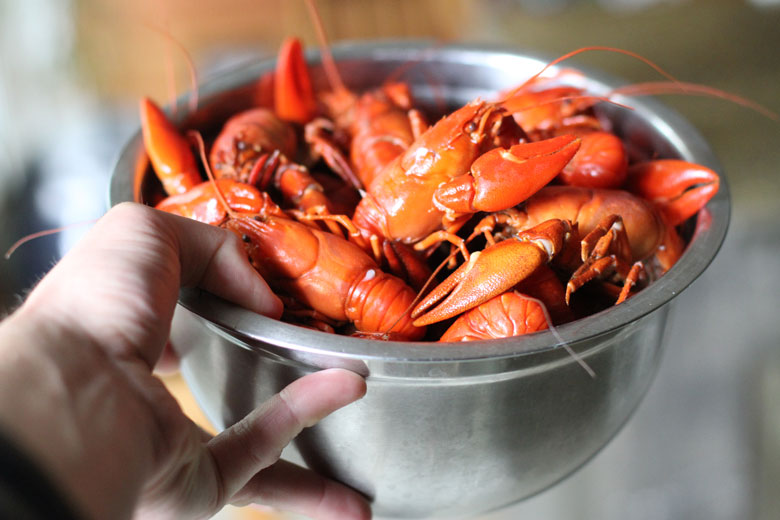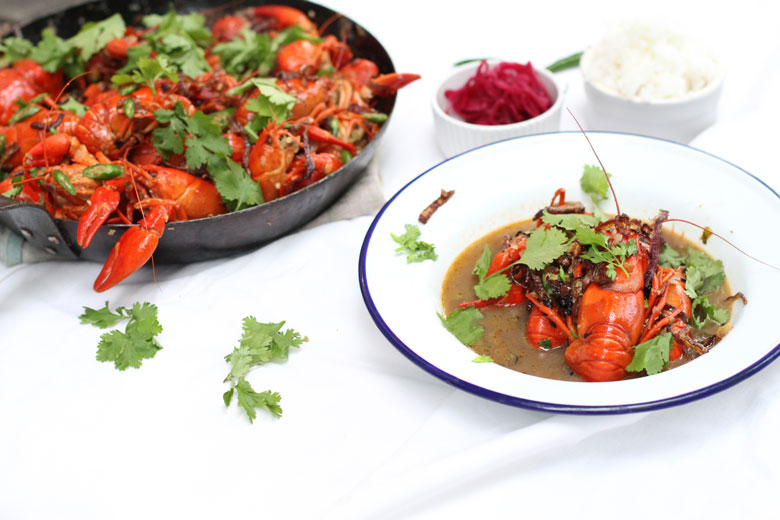Red alert
Prolific, voracious, invasive and totally delicious, it’s our gastronomic and environmental duty to catch, cook and eat American red signal crayfish, says Tom Hunt.
Several years ago, at Wilderness Festival in the Oxford countryside, the weather was so hot that the lakes had reached a blissful temperature: cool enough to refresh, but warm enough to wallow and enjoy. Swimming in a lake is a blissful pastime: the serene stillness of the water, inverted reflections of the trees and the dragonflies whizzing past your head are a recipe for contentedness. Until, that is, you get pincered on the toe by a crayfish.
Also known as mudbug, yabbie or freshwater lobster, a crayfish is a freshwater crustacean, similar to a langoustine or small lobster, and a member of the super-families Astacoidea and Parastacoidea. Like dragonflies, crayfish are a good sign of clean waterways. More to the point, they pack quite a pinch.
Swiftly pulled from my tranquil state of mind, I yelped and stood up, sinking my feet deep into the silty mud below, terrified of what else might be lurking beneath. I swam to the side and calmed down, daydreaming in the sun and drying off. As I lay there, I mused about barbecues and remembered that crayfish make really good eating. “The lake must be full of them!” I thought. And I was right.
The American red signal crayfish is now the most dominant species in the UK. They are an invasive species, introduced to Europe in the 1960s to supplement the Scandinavian fisheries that were then suffering from crayfish plague. But, as it turned out, the imports were actually carriers of the disease and made the situation worse. They are also more prolific than our native white-clawed crayfish and over the years have steadily wiped them out, almost to the point of extinction. Crayfish are cannibals and the red signal variety being so much larger, they often literally eat our natives for breakfast, along with fish roe, juvenile fish and just about anything else they can get their claws into – a real environmental nuisance.
Consequently, by catching and eating red signal crayfish we are doing a very good thing, helping to maintain species biodiversity and relieving over-infested waterways. Moreover, because crayfish hibernate by burrowing into the riverbanks, their sheer numbers contribute to erosion. It is therefore not only our gastronomic but also our environmental responsibility to tuck in. The large size of red signal crayfish make them really good, hearty eating.
I found all this out back at that Wilderness Festival, when – lo and behold – a local fisherman emerged to take advantage of the situation and set up a stall selling grilled crayfish down by the lake. Determined to get my own back on my attacker, I had a nice lunch. The fisherman served the crayfish quite simply with nothing but a wedge of lemon: super simple, super scrumptious.
If you fancy fishing for crayfish yourself, you must first get a licence from the Environment Agency – it’s easy and it’s free (click here for more information). To catch your own crayfish all you need is a small crayfish basket – similar to a lobster pot – and some bait: cat food or old fish is ideal. As for where to look, crayfish are so prolific you can find them just about anywhere aquatic; in lakes, rivers, ponds, even the Serpentine.
When it comes to cooking them, crayfish make a brilliant sustainable alternative to king prawns and can be treated in much the same way. Grill them over charcoal, cook up a jambalaya, fry them in garlic and paprika, serve à la Thermidor or with a Marie Rose sauce, or even cook up a traditional New Orleans style broil.
My friend Gus Hoyt worked in Louisiana for a while and describes a traditional crayfish broil so well. (Over there they call them crawfish, but don’t ask a fishmonger for that over here or you’ll get spiny lobster – quite different and much more expensive.) “Broiling crawfish is a Louisiana Bayou tradition which has cemented itself into Southern (and indeed US) culture. It’s a messy and super-social meal that normally has a ton of beer associated with it too. Most use a broil spice mix but this is basically made out of salt, cayenne, garlic and onion powder.
“I always like to sauté these in the pan first before adding water and spices. Then add lemon juice. Basically they eat a LOT of crawfish, about a kilo each. Serving traditional broil is great fun as you literally just dump the food onto a newspaper covered table top and everyone digs in. Like I said, pretty messy.”
Jungle curry with crayfish
My take on crayfish is a spicy coconut-free curry from northern Thailand called Kaeng pa. Although it’s traditionally made with catfish – a river fish similar to tilapia – it works really well with sweet whole crayfish. Kaeng pa has a spicy, thin sauce full of aromatic flavours like kaffir lime, shrimp paste and lemongrass. I’ve adapted this recipe from David Thompson’s Thai Food cookbook, the best and most in-depth Thai cookbook I’ve come across.
Ingredients
Serves 4
1kg live or whole boiled crayfish or 400g tilapia (keep 600ml of the cooking liquor to use as stock)
200ml vegetable oil for deep frying
6 red shallots or 3 red onions, thinly sliced
1 tbsp fish sauce
10 sprigs coriander, leaves picked, stalks kept for curry paste
Curry paste
Large pinch salt
10 green bird’s eye chillies, deseeded, finely chopped
2cm piece galangal or ginger, finely chopped
1 stick lemon grass, peeled and finely chopped
1 red shallot or half red onion, finely diced
4 cloves garlic, chopped
6 stalks of coriander, finely chopped
Zest and juice from one kaffir or regular lime
1 tsp roasted shrimp paste
Method
Crayfish notes:
- Choose a large pan, big enough to fit all the crayfish in and fill it with water. If you don’t have a pan big enough, cook the crayfish in batches.
- Salt the water and bring to the boil. When the water is boiling ferociously, add the crayfish and put the lid on top, tight. Return to the boil and cook for 2 minutes.
- When the crayfish have turned bright red they are ready. Remove them from the water using a slotted spoon, keeping the cooking liquid to use as stock.
- Make the curry paste in a pestle and mortar, or use a blender. Start by adding the drier ingredients and grind them to a paste then add the wetter ingredients and grind to a textured paste – salt, chillies, lemon grass, then galangal, shallot, garlic, coriander stalks, then lime juice and shrimp paste. Put to one side.
- Heat the oil in a wok or large frying pan until medium hot – making sure the oil is no higher than a third of the way up the side of the pan. Deep fry the shallots in batches until golden and crispy, then remove with a slotted spoon and put to one side. Remove all the oil except for a little to fry the curry paste. Over a high heat, fry the paste stirring constantly until it becomes pungent and “fragrant enough to produce a sneeze”, as David Thompson says.
- Add the fish sauce and 600ml of the cooking stock, bring to the boil. Add the crayfish (or tilapia, if using) and place a lid on top for three minutes.
- Stir in the fried shallots and coriander leaves and serve with rice and pickles.
Ask (or search) for: Red signal crayfish. Absolutely avoid white-clawed crayfish
Recommended minimum size: Any
When to buy: All year round, but best in summer months
Tom Hunt is author of The Natural Cook: Eating the Seasons from Root to Fruit. He founded the Forgotten Feast, a campaign working on projects throughout the UK, to revive our cooking heritage and help reduce food waste and Poco, a festival café and award-winning restaurant in Bristol. Click here to read his blog, Tom’s Feast.








